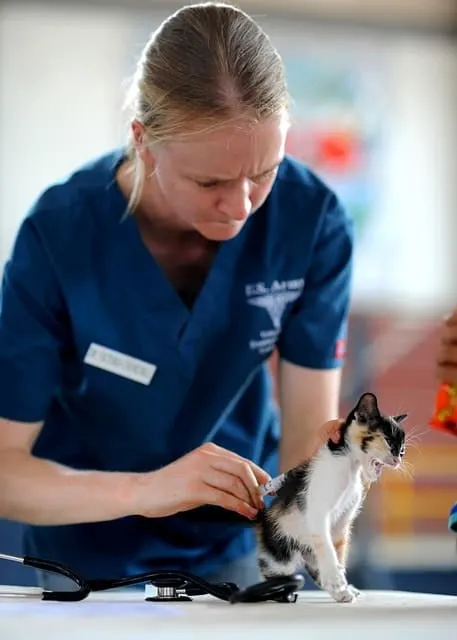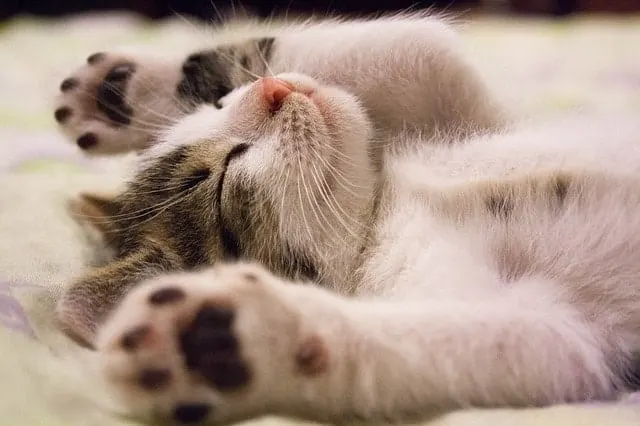If seasonal allergies make your eyes itchy, or a bee sting makes your finger swell, your doctor suggests you take an antihistamine to ease the symptoms.
So you may be wondering, “Can cats take Benadryl? If not, why not?” If antihistamines treat nasty allergic symptoms, why won’t they help my cat’s itchiness? Are antihistamines safe for your pet? The answer might surprise you.
In this article:
- Why Antihistamine?
- What is Benadryl?
- How Does Benadryl Work in Cats?
- Can Cats Take Benadryl?
- Uses Of Benadryl For Cats
- What Are the Side Effects?
- Final Thoughts: Can Cats Take Benadryl?
Why Antihistamine?
When the human body has an allergic reaction to new laundry detergent or a new crop of ragweed, it produces histamines.
Histamine is a chemical released in your body that causes the itching and inflammation in an allergic reaction. Anti-histamines block the H-1 receptors in your body to lessen or to keep the reaction from occurring at all.

Antihistamines such as diphenhydramine, the common name for the product Benadryl, work to counteract the effects of histamine on tiny blood vessels and relieves the itching, redness, and swelling.
Antihistamines also cause drowsiness and have a soothing effect on motion sickness.
What is Benadryl?
Benadryl is an antihistamine medicine used in reducing the effect of symptoms associated with allergy. These include itchy skin, nose or throat, watery eyes, cough, and sneezing. It is also utilized in treating vomiting and nausea caused by motion sickness. The active ingredient of Benadryl is diphenhydramine, and it comes in different forms, including tablets, gel, spray, liquid solution, cream, and capsules. According to vets, it is safe to provide Benadryl to cats only after her clinical examination.
How Does Benadryl Work in Cats?
Benadryl blocks histamine from being released in the body, thereby hindering the allergic reactions in humans as well as animals, including cats. It is used in treating itching, watery eyes, and sneezing in cats. The active ingredient responsible for reducing the effect of histamines is known as diphenhydramine.
Can I Give My Cat Benadryl?
We advise you to consult with your cat’s veterinarian before you give her medications meant for humans.
The consensus here though, is, yes. Unless your pet has a treatment for high blood pressure or a heart condition, veterinarians don’t seem to have a problem with giving antihistamines to pets.

Often, itching and rashes can be part of a different problem than a simple allergic reaction. You want to be sure that your cat is otherwise healthy before you start treating (and masking) the symptoms. A quick call to your vet will get you the definitive answer.
The most important factor in treating your animal with human medication is the matter of dosage.
Our research tells us that vets advise antihistamine dosage should be 1 milligram per 10 pounds of body weight. The average cat or small dog can take 1/2 of the usual human dose of 25 milligrams that probably comes in your very own bottle of diphenhydramine.

How you give the drug to the critter is up to you. Here is a very good video as to how to give medicine to your pet. (This video features a dog, but the basics are the same.)
Uses of Benadryl for Cats
Just like humans, Benadryl can be used for cats to treat the following health ailments.
Bug Bites
If your cat is itching and licking excessively, there’s a high chance she is suffering from a bug bite. This is common in the summer season when mosquitoes fly around and become a nuisance in life. Using Benadryl will help to reduce the itching and redness of the area affected by a bug bite.
Food and Environment Allergies
The body of cats tends to develop certain allergies due to the change in food diet or environmental factors. These triggers them to induce allergic reactions like sneezing, itchy skin, vomiting, or runny eyes. Benadryl will come handy in deteriorating the effectiveness of these symptoms.
Mild Sedative
Vet often recommend Benadryl as a mild sedative to help the cat relax while traveling. Unlike humans, cats don’t travel much and may panic.
Symptoms Due To Cold or Allergies
According to pet doctors, it is advised to treat felines with Benadryl when they are suffering from the following factors.
- Sneezing
- Coughing
- Irritate Eyes
- Watery Eyes
- Vomiting
- Snoring
- Swollen Paws
- Itchy Skin
Side Effects of Benadryl
In pets, as in humans, the most common side effect of antihistamines is drowsiness. They occur when an overdose of Benadryl is injected in cats. The potential side-effects include:
- Hyper-excitability
- Loss of appetite
- Dry mouth
- Decrease in urination
- Drowsiness
- Vomiting
- Diarrhea
If your kitty is suffering from any of the above side-effects, then it is best to visit your vet.
Final Thoughts: Can Cats Take Benadryl?
Like a number of other human-over-the-counter medications, Benadryl and its generic cousin diphenhydramine are safe and effective in treating itchiness and inflammation in your cat.
Nevertheless, we still advise you to chat with your pet’s doctor before launching off on your treatment. This is especially true if your pet happens to be pregnant or have a heart condition.
